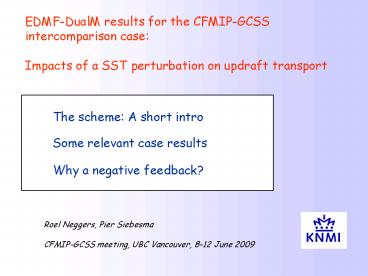The scheme: A short intro - PowerPoint PPT Presentation
1 / 19
Title:
The scheme: A short intro
Description:
EDMF-DualM results for the CFMIP-GCSS intercomparison case: Impacts of a SST perturbation on updraft transport The scheme: A short intro Some relevant case results – PowerPoint PPT presentation
Number of Views:98
Avg rating:3.0/5.0
Title: The scheme: A short intro
1
EDMF-DualM results for the CFMIP-GCSS
intercomparison caseImpacts of a SST
perturbation on updraft transport
- The scheme A short intro
- Some relevant case results
- Why a negative feedback?
Roel Neggers, Pier Siebesma CFMIP-GCSS meeting,
UBC Vancouver, 8-12 June 2009
2
The Eddy Diffusivity Mass Flux (EDMF) approach
Combining the diffusive and advective models in
the parameterization of the turbulent-convective
flux
The single updraft limit of EDMF
Applicable to well-mixed layers
Implemented in ECMWF IFS KNMI RACMO
etc.
Transporting updraft
K diffusion
AK
Aup
3
The dual updraft limit of EDMF shallow cumulus
Moist updraft
Dry updraft
K diffusion
au1
au2
AK
Aup
The single transporting updraft of EDMF is
further partitioned into a dry updraft and
a moist (condensed) updraft
4
Reconstructing a double PDF in conserved
variable space Extending EDMF into the
statistical modelling of clouds
Test parcel
Moist updraft PDF tied to the test parcel and
moist parcel
Moist parcel
x
x
Diffusive PDF residual of diagnostic variance
budget and moist updraft PDF
The Dual Mass flux scheme, Part I Transport.
Neggers et al. (JAS, 2009, vol. 66, 1465-1489)
Part II Clouds. Neggers (JAS, 2009, vol.
66, 1490-1506)
5
Why two updrafts? ? One scheme fits all
1 updraft
1 updraft
2 updrafts
6
Submitted version of EDMF-DualM for CFMIP-GCSS
Developed for the ECMWF Integrated Forecasting
System (IFS) Status Implementation
completed, now in test phase (scores
optimalization) K diffusion model
K-profile method for the well-mixed layer
Explicit flux at mixed-layer top
Ri-diffusion in the cloud layer and at cloud
top StCu triggering criterion (single moist
updraft mode) LTS (as in operational
IFS) SCM code details IFS/RACMO version
CY31R1 Native deep convection scheme
switched off EDMF-DualM scheme
does all convective transport
7
Case results - Cloud fraction
S6
S11
S12
S12 Stable equilibrium, single well-mixed
layer S11 Stable equilibrium, decoupled S6
After an initial shallow cu period, the scheme
tries to go deep (updraft rain
disturbes mixed layer, causing oscillation)
8
Where do our simulations sit in the transition?
S6
S11
S12
(Albrecht 1996)
9
Humidity structure
S6 fair weather cu (very weak inversion)
S11 decoupled
S12 well mixed
2K SST PBL depth increases
10
Cloud fraction EDMF contributions
S6
S11
S12
2K SST Total cloud fraction doesnt change
much (no discrete regime change)
LCL unchanged for the cumulus regimes S6 and S11
11
Cloud condensate EDMF contributions
S6
S11
S12
2K SST Condensate on the diffusive PDF
increases for S11 and S12 Deeper
condensate layer in S6 (carried by upraft PDF)
12
Cloud-radiative impacts
Why?
13
Surface heat fluxes
The surface buoyancy forcing remains more or less
unchanged
14
A bulk mixed-layer interpretation qsat(SST)
and q
z
Boundary fluxes act on the jumps
qt
Top entrainment flux
Inversion jump
qtPBL
Surface evaporation
qsat(SST)
q
Surface jump
15
2K SST qsat(SST) changes much more than qt
16
Control
2K SST
qt
Top entrainment flux
qtPBL
Evaporation
qsat(SST)
Both jumps increase The new equilibrium is
associated with stronger fluxes at the boundaries
17
Impacts of increased surface evaporation on
the EDMF transporting updrafts
Through the updraft initialization scheme, a
stronger E leads to larger updraft initial qt
excesses
variance
updraft fraction
As a result, the total updraft qt flux increases
18
The updrafts are efficient in transporting
moisture upwards to the top of the PBL This
favors capping cloud formation if the inversion
remains strong enough
19
Summary
The negative cloud-climate feedback in EDMF-DualM
seems related to the increase in surface
evaporation Through the updraft initialization
scheme, the enhanced evaporation leads to
increased updraft initial humidity excesses. This
extra humidity is efficiently transported by the
updrafts to the PBL top, which favors the buildup
of condensate in the capping cloud layer The PBL
updrafts do not get more energetic they just
carry more humidity around Remaining question
how and why does the top entrainment flux in the
model change? General remark In studying
feedbacks of PBL clouds on climate, the change in
free tropospheric humidity is as important as the
change in SST Should we try some experiments
with a different change in qt?































